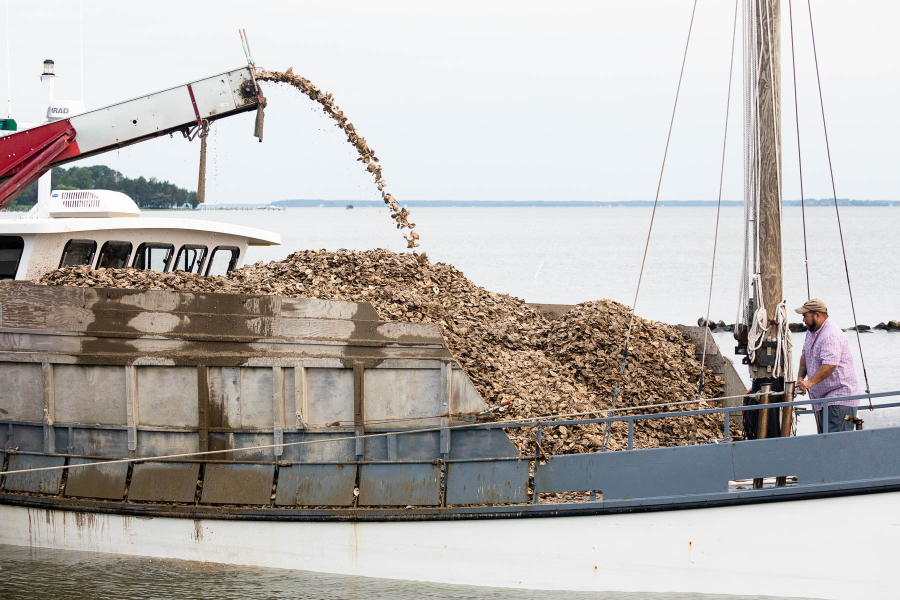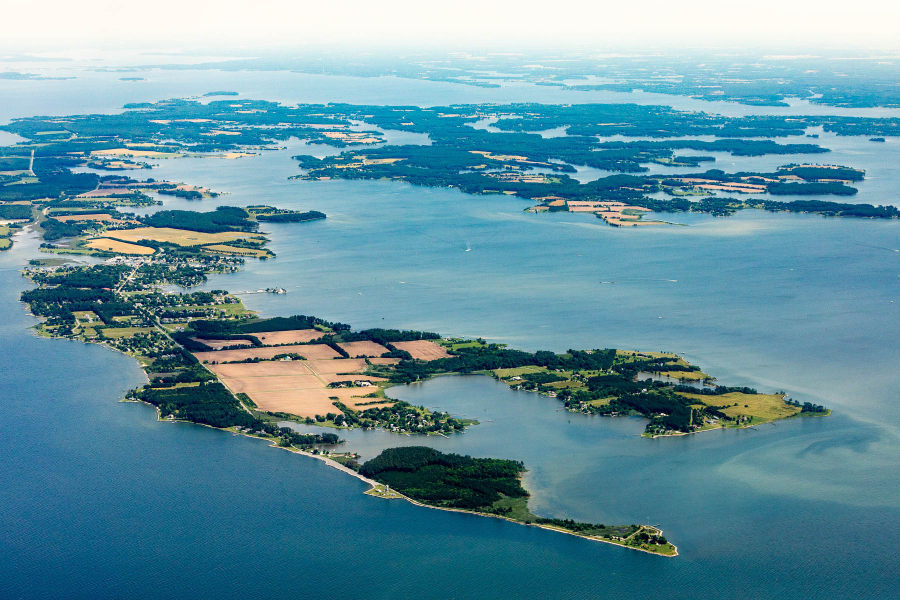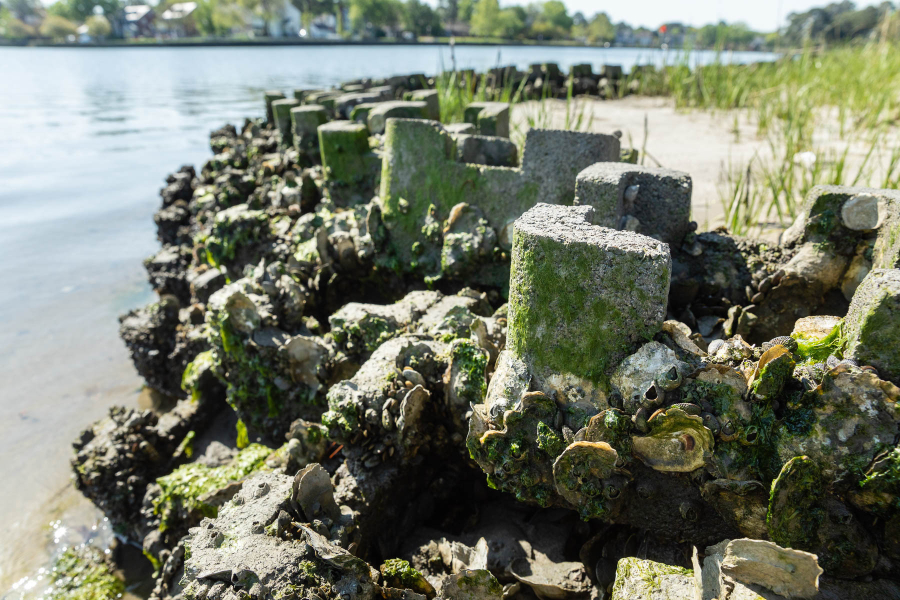40 years of dedication to Chesapeake Bay oysters—and their many benefits
NOAA’s role in advancing oyster habitat restoration in the Chesapeake Bay

Oysters—Crassostrea virginica—have long been an iconic species of the Chesapeake Bay. Thousands of years ago they were enjoyed by Indigenous peoples as a healthy source of protein. Even just hundreds of years ago, they grew in reefs that were so large, boats had to navigate around them. Large communities of oyster reefs around the Chesapeake helped filter the water and provided habitat for other Bay species.
But starting in the late 1800s, the Chesapeake’s oyster population began to decline due to overfishing, disease, habitat loss and pollution. By the 1990s, there were only 1–2% of historic levels of oysters left in the Bay.
Realizing the importance of oysters and oyster reefs to the health of the Chesapeake Bay and the regional economy, environmental leaders and community groups initiated projects to return the bivalve to Chesapeake waters. The work began with small-scale projects and growing awareness that oysters needed to be restored, and evolved into what is by far the largest oyster restoration project in the world.
Scientists at NOAA—the National Oceanic and Atmospheric Administration—have been leaders and proud partners in this work since it started. We currently lead the Maryland and Virginia Oyster Restoration Interagency Teams, which plan, implement, monitor and evaluate large-scale oyster restoration work currently under way.
Large-scale oyster restoration in the Chesapeake Bay is only possible thanks to a great partnership including the U.S. Army Corps of Engineers in Norfolk and Baltimore; state agencies like the Maryland Department of Natural Resources and Virginia Marine Resources Commission; nonprofit organizations including the Oyster Recovery Partnership, Chesapeake Bay Foundation, Lynnhaven River NOW, Elizabeth River Project and The Nature Conservancy; and academic institutions including the University of Maryland Center for Environmental Science, Virginia Institute of Marine Science, Morgan State University and Christopher Newport University.

Getting started: Raising awareness and involvement
The 1987 Chesapeake Bay Agreement set forth commitments including to “provide for the restoration of shellfish stocks in the Bay, especially the abundance of commercially important species.” Bringing this effort to reality, restoration projects around the Bay in the 1990s were scattered around many tributaries and often involved community groups planting a few acres of oyster reefs. These efforts greatly helped raise awareness of the importance of oysters and let people pitch in to help build these reefs.
The Chesapeake 2000 Agreement took this work up a step, by committing to achieving—at a minimum—a tenfold increase in native oysters in the Chesapeake Bay by 2010. Signatories also committed to focusing on restoration in sanctuaries, supporting aquaculture, and exploring disease resistance
Evaluating potential introduction of a non-native oyster
The ambitious goals of Chesapeake 2000 meant that the restoration work needed to be bigger than it was in the 1990s. But at that time, scientists weren’t confident that this could be done using only native oysters. To innovate on how to restore oysters, scientists and decision makers explored whether adding a species of oyster originally from Asia—Crassostrea ariakensis—to the Bay could help boost the population by being more disease-resistant.
A large research effort, including significant funding from NOAA, took place to identify the impacts and weigh the pros and cons of introducing a new species to the Bay.
Ultimately, the decision was made in 2009 to not add the non-native species of oyster to the Bay. While they grew fast and were resistant to the two diseases affecting native oysters, they were more vulnerable to predators and poor water quality, and died off relatively quickly when exposed to low dissolved oxygen levels—as often happens in Chesapeake summers.
During their research, experts worked with a “triploid” version of oysters. A triploid contains a third set of chromosomes, and is sterile—not able to reproduce. Scientists used these triploid versions of Crassostrea ariakensis to avoid an accidental introduction of the species into the Bay. They noticed that the triploid versions of our native Crassostrea virginica grew a lot faster than the standard “diploid” version—so fast that it could grow to harvest size before potentially being affected by the harmful diseases. Use of the triploid version of Crassostrea virginica has helped oyster aquaculture in Maryland and Virginia grow.

Executive Order raises the effort
The Chesapeake Bay’s oyster restoration effort received another boost starting in 2009, when former President Barack Obama signed an Executive Order that called for a renewed federal effort to protect and conserve the Chesapeake Bay, which he termed a “national treasure.” Federal agencies developed action plans in response to requests in the Executive Order, and concepts were floated to restore native oyster habitat and populations in as many as 20 tributaries by 2025.
Federal agencies dug into planning and worked with partners to explore whether an effort this ambitious—restoring hundreds of acres in some tributaries—was even possible. Where could partners find the hard substrate to serve as the reefs’ base? Could hatcheries produce enough juvenile oysters to “seed” all these reefs? It was a tall challenge, but one that the Chesapeake Bay Program partners were eager to meet. Partners increased capacity and funding to deal with these issues.
Another challenge restoration experts had with earlier goals was that they had no concrete way to measure success. Having more oysters is good—but what would a truly successful restored tributary look like? Scientists got together to discuss and set clear metrics for determining whether an area was successfully restored. The metrics include things like numbers of live oysters per square meter and whether the height of the reef is persisting rather than sinking into the Bay bottom or being removed by predators.
All of this planning led to development of the Oyster Outcome in the 2014 Chesapeake Bay Watershed Agreement, which committed the partnership to restore native oyster habitat and population in 10 tributaries by 2025. Federal and state agencies, nonprofit organizations, local governments and academic institutions all play important roles in the work to achieve the overall goal, which will restore as much as 1,800 acres of oyster habitat by 2025. As of the end of 2022, partners had restored 1,389 acres—that’s more than two square miles of healthy habitat.
This restoration is happening in areas where oyster harvest is not allowed. That’s so that these reefs will exist in perpetuity, providing ecosystem services that would last and not be removed when oysters were harvested. However, many commercial and recreational fishermen enjoy these areas for other opportunities, as species including striped bass and blue crabs spend time among oyster reefs.
In addition, many of the restored reefs are located near areas where oyster harvest is open. Oysters are “broadcast spawners”—they simply release eggs and sperm that become free-floating larvae. The Bay’s currents move the larvae around until they settle on another hard surface to grow—so larvae from restoration reefs can settle on areas intended for harvest, too.
Shining a spotlight on oysters’ many benefits
Restoring oysters requires a big investment in money, resources, expertise and staffing. To help quantify what dividends this investment pays, NOAA provided funding for research into the benefits that restored oyster reefs bring to the ecosystem and the economy.
Scientists found that successful oyster reefs are expected to remove about seven times more nitrogen each day than unrestored sand/mud bottoms can, which reduces the likelihood of harmful algae blooms and low-oxygen “dead zones” in the Bay. In addition, a study shows that juvenile crabs had three to four times better chance of surviving predators if they were on a reef than if they were on sandy bottom.
Looking at the economic value, scientists found that compared to a fished-down starting point, fully mature oyster reefs in one Bay river system would yield $20 million per year in surrounding counties associated with enhanced commercial and recreational fishing opportunities over those restored reefs. The opportunities linked to healthy reefs in just three of the large-scale restoration tributaries would add more than 300 part- and full-time jobs.
We are getting close to achieving our current goal. As of the end of 2022, seven out of the 10 tributaries selected for this large-scale oyster restoration were deemed “complete.” In those rivers, scientists will continue to monitor the project to make sure they are filled with healthy oysters. Monitoring so far has shown that the reefs created in the effort are wildly successful. For example, more than 95% of reefs monitored in Maryland meet the requirements for oyster density and biomass.
But what comes after 2025, and after the goals of the current Chesapeake Bay Watershed Agreement? While that’s still two years away, scientists, resource managers and decision makers are already working to decide what the next goals for oysters in the Chesapeake Bay will be. Concepts include integrating aquaculture and wild harvest into restoration projects and exploring ways to enhance fish habitat that also add resilience to coastal communities contending with erosion and storm surge. We’re excited by what the future can hold for the Chesapeake Bay Program—and Chesapeake Bay oysters!

Comments
There are no comments.
Thank you!
Your comment has been received. Before it can be published, the comment will be reviewed by our team to ensure it adheres with our rules of engagement.
Back to recent stories